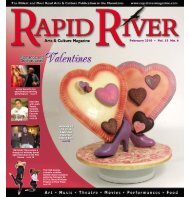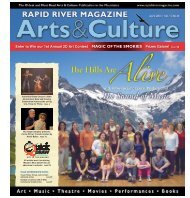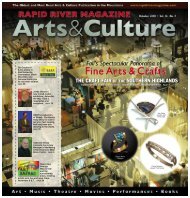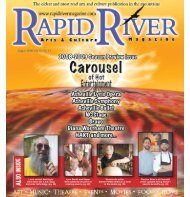JOHN MAC KAH - Rapid River Magazine
JOHN MAC KAH - Rapid River Magazine
JOHN MAC KAH - Rapid River Magazine
You also want an ePaper? Increase the reach of your titles
YUMPU automatically turns print PDFs into web optimized ePapers that Google loves.
R A P I D R I V E R A R T S & C U L T U R E<br />
healthy lifestyles<br />
The Obvious Assumption<br />
Dietary information is of two<br />
kinds: simple and complex.<br />
The simple information<br />
categorizes everything into<br />
a few groups, either stigmatizing<br />
the bad groups or promoting a<br />
particular good group. The complex<br />
information breaks everything down<br />
into multiple options that require a<br />
chemistry/physiology degree to understand<br />
and implement.<br />
This is especially true when trying<br />
to understand fatty acids: their<br />
intake, their functions in the body,<br />
and their proper balance in the diet.<br />
Let’s try a middle ground for consideration<br />
– a little complex information<br />
without too much chemistry and a<br />
little simple information without too<br />
much stigmatizing.<br />
Most of the complex nutrients<br />
required for optimum human health<br />
can be made by the human body. But<br />
there are a few nutrients that humans<br />
cannot make. These nutrients are<br />
labeled “essential” nutrients – which<br />
means they must be supplied in the<br />
diet. In the category of fats, two fatty<br />
acids must be supplied in the diet. The<br />
human body cannot make alpha-linolenic<br />
acid (an omega-3) fatty acid and<br />
linoleic acid (an omega-6) fatty acid.<br />
From both of these two fatty acids,<br />
the human body can manufacture<br />
on its own (with some effort) the rest<br />
of a myriad of fatty acids that make<br />
up most of the human brain, much of<br />
the human nerve cells, and the major<br />
building blocks of the capsule of all<br />
human cells. Various fatty acids are the<br />
messengers that make possible blood<br />
clotting, passing of various elements<br />
through cell walls, natural pain killers,<br />
and the immune inflammatory system<br />
that recognizes, isolates, and eliminates<br />
foreign material: bacteria, viruses, and<br />
cancer cells.<br />
EPA and DHA are two omega-3<br />
fatty acids that can be made from the<br />
essential fatty acids, even by children.<br />
These two have been shown to be especially<br />
important for brain and nerve<br />
growth and in lowering the risk of<br />
inflammation, heart disease, arthritis,<br />
mental health problems, and possibly<br />
some cancers. They are more easily<br />
absorbed from the diet than made in<br />
the body, especially by children. They<br />
are both added to various foods, especially<br />
formula for infants.<br />
Arachidonic acid is an omega-6<br />
fatty acid that is made in the body and<br />
is important for blood clotting, repair<br />
and growth of muscle and nerve tissue,<br />
improved sensitivity to insulin, and<br />
control of eczema. It is the precursor<br />
for the fatty acids that cause degenerative<br />
arthritis.<br />
Omega-3 and omega-6 fatty acids<br />
both play vital roles. They are best<br />
absorbed in the diet in a ratio of 5<br />
(omega-6) to 1 (omega-3). In the typical<br />
American diet with its emphasis on<br />
fatty animal products (meat and dairy)<br />
BY MAX HAMMONDS, MD<br />
the ratio is 24:1 which throws the<br />
balance toward greater inflammation,<br />
greater blood clotting, and a more reactive<br />
immune system – a major cause of<br />
many chronic diseases – not to mention<br />
the other disease processes caused<br />
by such a diet. What is the answer to<br />
this imbalance? Correct the imbalance<br />
through diet.<br />
The obvious assumption is – decrease<br />
the intake of omega-6 fatty acids<br />
and correct the imbalance. But that<br />
would require decreasing the intake of<br />
America’s favorite fatty foods. Instead<br />
nutritionists suggest taking in more<br />
omega-3 fatty acids by supplementation<br />
– with cold water fish, flax seed,<br />
canola oil and others. In other words,<br />
they assume that people will not<br />
choose to eat more healthfully and add<br />
supplements to correct the problem.<br />
Two Lessons<br />
Two assumptions seem obvious.<br />
1) If one eats a diet that is already wellbalanced<br />
in the omega-6:omega-3 ratio<br />
(Mediterranean diet), no supplementation<br />
is necessary. It is only intended for<br />
those not eating a good diet. 2) If one<br />
eats a diet that is out of balance, change<br />
the diet – don’t ignore the imbalance<br />
or correct the imbalance with supplements.<br />
Oh, yes – breast milk gives the<br />
infant the same balance of omega-6:<br />
omega-3 as that which the mother eats.<br />
Obvious assumption.<br />
ASAP’s Local Food<br />
Guide Turns 10<br />
O<br />
ver the last decade, Appalachian<br />
Sustainable Agriculture<br />
Project (ASAP) has<br />
spearheaded a Local Food<br />
Campaign to support those<br />
on a journey to reconnect with their<br />
food. At the center of it all has been<br />
the Local Food Guide. Since 2002,<br />
nine editions and almost one million<br />
copies have been printed to help<br />
people get to know area farmers, find<br />
CSAs, and easily seek out local food at<br />
grocery stores, tailgate markets, restaurants,<br />
and other businesses.<br />
To celebrate the new 10th edition,<br />
as well as the growth of the local food<br />
movement in the Southern Appalachians<br />
over the years, ASAP is hosting<br />
a Local Food Guide release party. The<br />
event, to be held May 7 from 4 to 8<br />
p.m. at Asheville’s Highland Brewing<br />
Company, is an opportunity to pick<br />
up the 2011 guide<br />
hot off the press,<br />
enjoy giveaways<br />
and music by local<br />
act Uncle Mountain, and kick off the<br />
growing season with other local food<br />
enthusiasts.<br />
Of course, what would a local<br />
food guide party be without local<br />
food—washed down with local brews?<br />
Tupelo Honey Café will be on hand to<br />
prepare farm-fresh bites, as well as sell<br />
their new cookbook, Tupelo Honey<br />
Cafe: Spirited Recipes from Asheville’s<br />
New South Kitchen, with sales to<br />
benefit ASAP.<br />
“Ten years ago when we printed<br />
the first Local Food Guide, we could<br />
not have imagined how much could<br />
change in a decade,” says Charlie<br />
Jackson, ASAP’s director. “Today,<br />
the guide is the most comprehensive<br />
source for local food in the country,<br />
and the Appalachian region leads a<br />
national local food movement that is reshaping<br />
our farms and the way we eat.”<br />
Those unable to attend can browse the<br />
guide online at buyappalachian.org.<br />
IF<br />
YOU<br />
GO<br />
BY MAGGIE CRAMER<br />
ASAP’s Local Food Guide<br />
release party is free and open<br />
to the public at Highland<br />
Brewing Company’s new Tasting<br />
Room, 12 Old Charlotte Highway,<br />
Suite H, Asheville. For more<br />
information, visit asapconnections.<br />
org/lfgparty.html.<br />
30 May 2011 — RAPID RIVER ARTS & CULTURE MAGAZINE — Vol. 14, No. 9
















